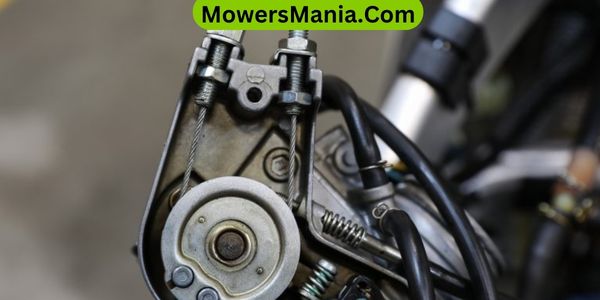If your lawn mower’s throttle is stuck, you’ll want to fix it quickly to get back to mowing. In this article, we’ll show you how to identify the issue, clean and lubricate the mechanism, and make any necessary adjustments.
By following these steps, you can ensure your lawn mower’s throttle operates smoothly and efficiently, allowing you to tackle your yard work with ease.

Understanding the Throttle System
To understand why your lawn mower throttle is stuck, examining the throttle system’s components and functions is essential.
The throttle system consists of several key parts that work together to control the engine’s speed. First, there’s the throttle lever, which you manipulate to adjust the speed of the engine.
This lever is connected to the throttle cable, which runs to the engine and controls the throttle plate. The throttle plate regulates the airflow into the engine, affecting its speed.
When you move the throttle lever, it should smoothly adjust the throttle plate’s position to change the engine speed. However, if the throttle lever is stuck, it could be due to a few different issues.
The throttle cable might be frayed or stuck, preventing the throttle plate from moving properly. There could also be debris or gunk built up around the throttle mechanism, hindering its movement.
Understanding these components and their functions will help you diagnose and fix the stuck throttle issue with your lawn mower.
Identifying the Sticking Point
First, you should start by visually inspecting the throttle cable for any signs of wear or damage.
Then, try moving the throttle lever back and forth to feel for any resistance or sticking points.
If you notice any areas where the cable seems to be catching or sticking, that’s likely the source of the problem.
Throttle Cable Inspection
Inspect the throttle cable by visually examining its entire length for any signs of fraying, kinking, or other damage.
Check for the following issues:
- Fraying: Look for any unraveling or wear on the outer casing or inner wire.
- Kinking: Identify any sharp bends or crimps that may be restricting the cable’s movement.
- Corrosion: Check for rust or corrosion on the cable, particularly at connection points.
- Obstructions: Ensure there are no obstructions along the cable’s path, such as debris or dirt buildup.
Identifying these potential issues will help you pinpoint the sticking point and address it effectively to restore proper throttle functionality.
Lubrication for Smoothness
After inspecting the throttle cable for any signs of damage, it’s important to address the sticking point by applying lubrication for smoothness.
Start by locating the areas where the throttle cable meets the moving parts. Apply a small amount of lubricant to these points, ensuring that it reaches the inner components.
Then, manually move the throttle control back and forth to distribute the lubricant evenly. Check for any signs of improvement in the throttle’s movement.
If the throttle still feels stiff, reapply the lubricant and continue working it into the cable. Be sure to use a lubricant specifically designed for throttle cables to prevent any damage.
Once the lubrication is applied, test the throttle again to ensure that it moves freely and without resistance.
Cleaning and Lubricating the Throttle Mechanism
To fix a stuck lawn mower throttle, start by cleaning and lubricating the throttle mechanism with a suitable degreaser and lubricant.
Here’s how to do it:
- Disconnect the Spark Plug: Before working on the throttle mechanism, always disconnect the spark plug to prevent accidental starts.
- Remove Debris and Dirt: Use a brush or compressed air to remove any dirt, grass, or debris that may be causing the throttle to stick. Ensure that the throttle mechanism is free from any obstructions.
- Apply Degreaser: Use a suitable degreaser to clean the throttle mechanism thoroughly. Spray the degreaser and use a rag to wipe away any grime or buildup.
- Lubricate Moving Parts: Once the throttle mechanism is clean and dry, apply a suitable lubricant to the moving parts. Be sure to use a lubricant that’s specifically designed for small engines to ensure smooth operation.
Adjusting the Throttle Cable Tension

Once you have cleaned and lubricated the throttle mechanism, you can proceed with adjusting the throttle cable tension to ensure proper functionality.
Start by locating the throttle cable where it connects to the engine. Loosen the cable clamp using a wrench and adjust the tension by pulling the cable tighter or loosening it as needed.
Ensure that there’s no slack in the cable when the throttle is in the idle position. Once adjusted, tighten the cable clamp back in place to secure the new tension setting.
Next, test the throttle to see if it moves smoothly from idle to full throttle. If it feels stiff or doesn’t move freely, readjust the cable tension until the throttle operates smoothly across its entire range.
After making adjustments, start the lawn mower and observe how the throttle responds. If necessary, fine-tune the tension until the throttle functions properly.
Proper tension in the throttle cable is crucial for the smooth operation of your lawn mower. By following these steps, you can ensure that the throttle cable is adjusted correctly, allowing for seamless control of your lawn mower’s speed and power.
Inspecting and Replacing Damaged Components
- First, check the throttle cable for any signs of fraying or kinking. If you notice any damage, replace the cable to ensure smooth operation.
- Next, inspect the springs for wear or breakage, and replace them if necessary.
- Lastly, examine the control lever for any signs of wear or damage, and replace it if needed to restore proper throttle function.
Check Throttle Cable
Inspect the throttle cable for any signs of wear or damage to identify components that need replacing.
Look for the following issues:
- Fraying or kinks in the cable.
- Rust or corrosion on the cable or at connection points.
- Loose or disconnected cable ends.
- Any signs of stretching or breakage in the cable.
If you notice any of these issues, it’s important to replace the damaged components to ensure proper throttle functionality.
Start by disconnecting the throttle cable from the engine and throttle control lever. Then, carefully remove the damaged components and replace them with new ones.
After installing the new components, reattach the throttle cable and test the throttle to ensure it moves smoothly without any sticking or resistance.
Replace Damaged Springs
You can start by examining the springs for any signs of damage or wear, and if necessary, replace them to restore proper throttle function.
Begin by locating the throttle linkage and identifying the springs connected to it. Look for any visible signs of stretching, corrosion, or breakage. If the springs appear worn or damaged, carefully remove them and take note of their size and configuration.
Visit a local hardware store or order the replacement springs online. Once you have the new springs, carefully install them in the same position as the old ones. Ensure that they’re securely attached and provide the necessary tension to control the throttle.
Reassemble the throttle linkage and test the mower to confirm that the new springs have resolved the issue.
Inspect Control Lever
Examine the control lever for any signs of wear or damage, ensuring it moves smoothly and without resistance.
Check for the following:
- Cracks or breakage in the lever
- Loose or missing screws or bolts
- Any obstructions that may be hindering its movement
- Excessive dirt, rust, or debris buildup
If you notice any damage or wear, consider replacing the control lever to ensure proper functionality. Clean any buildup or obstructions and tighten any loose screws or bolts.
A smooth and unobstructed control lever is essential for the proper operation of the lawn mower throttle. By inspecting and, if necessary, replacing damaged components, you can ensure that the control lever operates effectively, allowing for smooth and efficient adjustments to the mower’s throttle.
Testing and Fine-Tuning the Throttle Operation

To check the throttle operation, start by gently moving the throttle lever back and forth to ensure smooth movement. If the lever feels stiff or unresponsive, it may indicate a need for lubrication or adjustment.
You can begin by applying a light lubricant to the pivot points of the throttle lever and allowing it to penetrate. Then, work the lever back and forth to distribute the lubricant evenly.
After lubrication, check the throttle cable for any signs of fraying, kinking, or damage. A damaged cable can hinder the smooth operation of the throttle. If any issues are found, consider replacing the cable to ensure proper functionality.
Additionally, ensure that the throttle spring is properly attached and not stretched out, as this can affect the responsiveness of the throttle.
Once any necessary adjustments or maintenance have been performed, start the mower and test the throttle operation. Fine-tune the throttle lever and cable as needed to achieve the desired responsiveness and control.
Frequently Asked Questions [FAQs]
Can I Use Any Type of Lubricant to Fix a Stuck Throttle, or Is There a Specific Type I Should Use?
You should use a specific type of lubricant to fix a stuck throttle. Not all lubricants are suitable for this purpose. It’s important to choose one that is designed for throttle mechanisms to prevent potential damage.
What Should I Do if I Can’t Identify the Sticking Point in My Lawn Mower’s Throttle System?
If you can’t identify the sticking point in your lawn mower’s throttle system, try cleaning the throttle mechanism and lubricating it with a suitable lubricant. If the issue persists, consider seeking professional assistance for a thorough inspection.
Are There Any Common Mistakes People Make When Adjusting the Throttle Cable Tension That I Should Be Aware Of?
When adjusting the throttle cable tension, be careful not to over-tighten it, as this can cause the throttle to stick. Also, make sure the cable is properly lubricated to prevent friction and sticking.
How Can I Tell if a Component in the Throttle System Is Damaged and Needs to Be Replaced?
If the throttle isn’t responding smoothly, inspect the components for signs of wear or damage. Look for frayed cables, bent linkages, or stuck pivots. Any of these issues could indicate the need for replacement.
Is There a Way to Prevent My Lawn Mower’s Throttle From Getting Stuck in the Future, or Is It Just a Normal Part of Maintenance?
To prevent your lawn mower’s throttle from getting stuck in the future, regular maintenance is key. Cleaning the throttle system, lubricating moving parts, and avoiding excessive force on the throttle can help prevent this issue.
Conclusion
So there you have it – a few simple steps to fix a stuck lawn mower throttle.
By understanding the throttle system, identifying the sticking point, cleaning and lubricating the mechanism, adjusting the cable tension, inspecting and replacing damaged components, and testing and fine-tuning the operation, you can get your lawn mower back up and running smoothly in no time.
Happy mowing!



